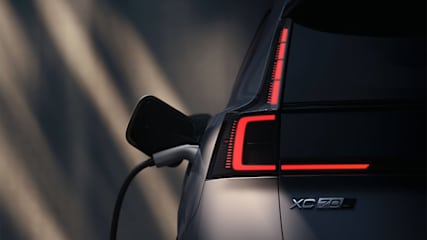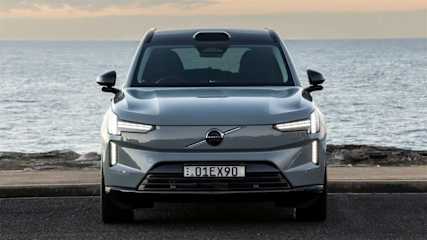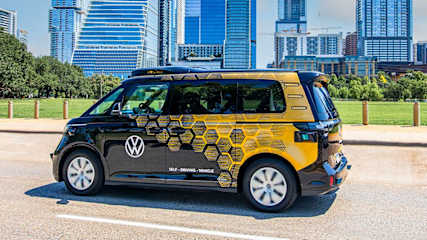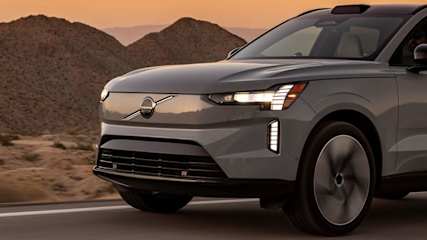Volvo 264 Reviews
You'll find all our Volvo 264 reviews right here. Volvo 264 prices range from $2,310 for the 264 Gle to $4,070 for the 264 Gle.
Our reviews offer detailed analysis of the 's features, design, practicality, fuel consumption, engine and transmission, safety, ownership and what it's like to drive.
The most recent reviews sit up the top of the page, but if you're looking for an older model year or shopping for a used car, scroll down to find Volvo dating back as far as 1975.
Or, if you just want to read the latest news about the Volvo 264, you'll find it all here.
Volvo Reviews and News

Head-turning new family SUV revealed: The 2026 Volvo XC70 is a plug-in hybrid SUV rival for the Land Rover Discovery Sport, Lexus NX, and Mazda CX-60 and potentially bound for an Australian launch
Read the article
By Jack Quick · 08 May 2025
Volvo is following the recent trend of carmakers reviving previous nameplates as higher-riding SUVs, and the latest is the XC70.The new Volvo XC70 has been globally revealed and is set to launch in China later this year.At this stage it’s unclear if it will launch in Australia, though the brand has said it’s exploring potential additional markets “at a later stage”.This new Volvo model slots above the XC60 as a slightly larger and more spacious mid-size SUV offering, but still sits beneath the large XC90.It’s built on Volvo’s 'Scalable Product Architecture' (SPA) platform, like the XC60, XC90, S60, and S90, among others.Volvo dubs the XC70 its first “extended-range plug-in hybrid”.While the Swedish-Chinese carmaker hasn’t fully detailed the car’s powertrain, it claims it can travel up to 200km on electric power alone, according to relatively lenient CLTC testing.Accompanying the reveal is a handful of images showing the XC70’s exterior, with Volvo noting more details will be provided in the coming months.At the front the XC70 has a shield-like closed grille similar to the brand’s electric models, and features an active grille shutter.There is also the classic 'Thor’s Hammer' headlight design which features matrix LED technology. This allows the headlights to stay on high-beam for as long as possible, as it can dip certain portions of the beam when it detects oncoming lights oncoming or tail-lights ahead.The XC70’s side profile is distinctly SUV-like, and around the back there are vertical C-shaped tail-lights integrated into the rear window.Volvo is far from the first carmaker to revive nameplates previously used on spacious wagons or people movers, and relaunch them as SUVs.Recent examples include the Ford Mustang Mach-E, Renault Megane E-Tech and Scenic and Mitsubishi Eclipse Cross, among others.The Volvo XC70 nameplate originated as a high-riding and more off-road-focused version of the V70 wagon, much like the Subaru Outback.Initially called the V70 XC, the XC70 name was introduced in 2003 to align with the newly introduced XC90.It was sold in Australia all the way up to 2016 when the model was retired globally.

They're not like us: The one reason Volvo doesn't fear its Chinese siblings Geely, Zeekr and Lynk & Co, or any other newcomer brands in Australia
Read the article
By Andrew Chesterton · 21 Apr 2025
Volvo insists it shouldn’t be considered among the influx of Chinese brands in Australia — despite the Swedish mainstay now being owned by China’s automotive giant Geely — telling CarsGuide that it has something none of them can offer.

Self-driving cars? They're dreaming | Opinion
Read the article
By Laura Berry · 18 Apr 2025
It’s started again - the talk about how autonomous cars are just around the corner.But are self-driving cars really going to be with us any time soon? Because it feels as though carmakers have been promising autonomous vehicles for a long time now, yet it seems like we’re still no closer to owning a vehicle that can drive us home or to work.Despite this, many car brands think autonomous vehicles are on our doorstep. Is that true? And if so, do we really want to let them in?Volkswagen’s global CEO of Commercial Vehicles Professor Dr Carsten Intra believes they are indeed imminent. “You think that going from combustion to electrification is a big change?” Dr Carsten asked Australia’s auto media last week at the Volkswagen Multivan launch. “And it is, but going autonomous will change our business. This is coming, it's in front of the door. Not just in 10 or 15 years, it will be sometime tomorrow. We are going through the world and testing our fleets in different cities.”Dr Carsten is referring to the fleet of self-driving ID. Buzz electric vans being tested by Volkswagen through its special autonomous company MOIA.Fitted with autonomous tech for full-self driving (but with a human babysitter on board) VW is testing the ID. Buzzes in the United States and Europe. The fleet has just been to Oslo, Norway for winter testing in snow and ice. The self-driving ID. Buzz has a high level of autonomous ability, level 4 actually, a level down from the fully autonomous Level 5 which doesn’t need a human chaperon. This is the level Volkswagen hopes to reach by 2030. These levels from 1 to 5 are just increasingly sophisticated forms of Advanced Driver Assistance Systems (ADAS). Most new cars are at Level 2 and have systems that can take over steering, braking and acceleration.But Level 5, which can handle any situation without driver input, is much more complicated. While it may work in theory or on a closed circuit, what about on the Pacific Highway in Sydney at 8:30am on a Monday?So with 2030 less than five years away and as a journalist who has written story after story as car company after car company has made promise after promise of autonomous vehicles, I can tell you that the chances of fully autonomous cars driving on Australian roads by 2030 are close to zero.Forgive me for being jaded, but the autonomous car dream is and probably will always remain a dream. I wasn’t always so pessimistic about this. Back in 2016 I was very excited to write a story for CarsGuide about Ford’s bold claim that it was so far advanced into mastering autonomous tech that they’d have self-driving cars everywhere by 2021.“Ford will be mass producing vehicles with full autonomy within five years and that means there will be no steering wheels, no gas pedals and no brake pedals - a driver is not going to be required," Ford’s then global chief Mark Fields announced.Well it’s 2025 and these pedal-less, steering wheel-less driverless cars are nowhere to be seen.Ford isn’t the only one. Most car companies in the past 10 years have said they are on the cusp of autonomous breakthroughs from Nissan, Mercedes-Benz and Audi to Volvo and Hyundai.Well they used to say that and many companies made bold claims, just like Ford’s, that they, too, would have autonomous cars in just a matter of years. But most of the car manufacturers have gone quiet on the topic of self-driving cars. All except Tesla with its so-called full self-driving function which is very likely just advanced driver assistance and not full self-driving. Actually in recent weeks Tesla has had to re-think what it calls its driving system due to regulatory issues in China.Tesla’s claims of having full-self driving modes 10 years ago probably caused the rest of the industry to suddenly work harder and faster on their own autonomous projects only for all of us to reach this point where we’ve discovered that you can absolutely teach a car to drive, but setting it loose on public roads is going to create a multitude of problems from safety and legal to ethical dilemmas. Besides, Volkswagen isn't the first to have fleets testing in cities. Ride-hailing companies such as Waymo have been working on autonomous tech for years only to run into operational difficulties with cars getting lost or even attacked.Until recently Waymo's fleet of autonomous taxis has operated in just the United States with San Francisco, Los Angeles and Austin being the main cities where the service can be found. Now Waymo is going further afield to Japan and is using Tokyo as its first location outsided the US to test the autonomous tech.Waymo will have been testing and operating its fleet of autonomous cars for 10 years in 2026. An achievement in itself and while the technology has come far it hasn't been without inicident. There have been cases where Waymo vehicles have malfunctioned or become confused. Two years ago in Phoenix 12 Waymos all turned up in the same street at the same time and caused a traffic jam, while last year in San Francisco a car park being used to hold dozens of Waymo vehicles erupted into chaos as the empty cars began honking at each other for no apparant reason.Hiccups aside it's truly amazing how well Waymo's fleet of electric Jaguar iPace SUVs can navigate through complicated terrain such as hilly San Francisco with its myriad of streets. Waymo has also recently signed a new deal with Chinese carmaker Zeekr to use its electric Mix people mover in 2025.Volkswagen's own testing with its ID. Buzz fleets will indeed add to the advancement of autonomous tech, too.Progress is slow, however, and for good reason - safety, regulations, ethics and the unpredicatability of other road users present huge challenges for a technology that's expected to be as good, if not better, than humans. Volvo is a safety tech pioneer in the auto industry and one of the first to start developing autonomous systems. But in 2023 Volvo Cars CEO and President Jim Rowan made a startling admission: self-driving cars won’t happen anytime soon. "So first of all, this big myth that there's five different levels of autonomy is nonsense, in my opinion," he said. "You've got two levels of autonomy. One is your hands on the steering wheel. One is your hands off the steering wheel."Can we drive a car fully autonomous? Yes. Does regulation allow that? No. So I think regulation will be the barrier towards full adoption of full AD more than technology," he said.“Driving inside the city when there's schools and roadworks, and there's a lot of change every day, I think that's a long, long way off.”So if the boss of the company which was so far ahead in developing fully autonomous cars has declared the mission more or less over for now, what’s caused Volkswagen to make its autonomous claims? Well, we’ll have to wait and see but I think we’ll be waiting a lot longer before we start seeing.

'Something has got to give': Volvo warns an Australian car market flooded with new brands is unsustainable, but vows it will survive in the face of XPeng, Deepal, Leapmotor and more
Read the article
By Andrew Chesterton · 11 Apr 2025
Volvo warns that "something has got to give" in Australia's new-car market, with too many brands now fighting for too few sales for all to survive.That's the word from Volvo Car Australia Managing Director Stephen Connor, with the senior executive also detailing how his brand will survive the new-marque onslaught."We've got 70-plus OEMs here, and we've probably got another 20 arriving on our shores in the next short period of time. It is crazy," he said."The market is, they reckon, 1.2 million this year. I personally think it's about one million, but let's go with the experts, and they're saying it's 1.2."So 1.2m (sales) with probably 90 OEMs – something has got to give."I think the people who will struggle are the people who are going to be fighting in that volume segment. And I think, good on the new entrants coming in. They're going to bring a new dynamic."Asked whether all 90 brands would still be in Australia in five years time, the executive replied "I don't think so"."I think there will be some consolidation, and this is only my personal view," he said, "I think some brands who have come in, the new ones, have gone, (saying) this is too hard and too difficult."His thoughts echo those of Kia, Toyota and other major players, all of whom suggest the new-car makeup in Australia is going to change, though Volvo is in a unique position, given several of the new players – Polestar, Geely, Zeekr and the soon-to-arrive Lynk & Co – are all part of its extended family .But Volvo says realistic expectations and a business model not contingent on extreme volume will ensure the marque survives in Australia."We're looking for marginal growth this year, which is okay. We've gathered production based on marginal growth," Mr Connor says."I think it's important for us to grow as a brand. But we don't need to grow by 20 per cent. Five per cent, two per cent – that's good enough for us as we go forward. Our production this year is based off about 9,500 units. And we're comfortable to achieve that."A changing product line-up will fuel that marginal increase, Mr Connor says, with some well-known models on the way out, replaced by vehicles the brand hopes will capture more sales."So S60 and V60, we say goodbye this year to those models. They were only about 300 cars a piece. There's a lot of time and energy spent just to sell 300 cars, and as you know, sedans are struggling in this marketplace," he says."We've got the EX90, which will be about 300 cars this year. We've got XC90, the new one. So that will be about 1100 units roughly. We'll get some extra growth from EX30 Cross Country. We have refreshed XC60, a big segment for us. It's normally about 3000 cars. Then later on this year we've got the ES90 as well, which will be small volumes again."But you see, we've consolidated the line-up. So that's where our growth will come from. Refreshed XC90, refreshed XC60. We've got obviously XC40, which is still a great seller for us as well, and then you've got EX30."

Shock hybrid small SUV bargain! Sexy electrified Euro crossover is set to rattle Lexus LBX, BMW iX2 and Volvo EX30
Read the article
By Byron Mathioudakis · 02 Apr 2025
Australia’s premium small SUV hybrid class is about to experience a shake-up with the arrival of the Alfa Romeo Junior.

Volvo EX90 Ultra Twin Motor Performance 2025 review: snapshot
Read the article
By Andrew Chesterton · 31 Mar 2025
The Ultra Twin Motor acts as the flagship model in the Volvo EX90 range, and lists at $134,990 plus on-road costs.It builds on the entry-level Plus’s equipment list — think four-zone climate control, a 14.5-inch central screen (vertical) with Apple CarPlay and Android Auto, but also Google built-in, giving you access to native maps and apps. Then there's wireless phone charging, a heated leather steering wheel — with niceties like ventilated seats up front, better High Definition Pixel headlights, and a wondrous 25-speaker Bowers & Wilkins High Fidelity stereo.Like the Plus, the Ultra is a twin-motor, AWD setup, delivering an impressive 380kW and 910Nm — and a sprint to 100km/h of just 4.9s.It nabs an 111kWh lithium-ion battery, and promises a WLTP driving range of 570km.When it comes time to charge, the EX90 is set up for 250kW DC fast charging, meaning 10-80 percent charged in 35mins. At home, a three-phase wallbox will take more like 10 hours. But if yours is only a 7kW connection, it will be slower still.

Volvo EX90 Plus Twin Motor 2025 review: snapshot
Read the article
By Andrew Chesterton · 29 Mar 2025
The Plus Twin Motor is the entry point to the two-model Volvo EX90 range - and we reckon it’s the pick of the bunch. After all, both models are twin-motor, AWD affairs, with the Plus delivering a total 300kW and 700Nm, while the Ultra dials it up to 380kW and 910Nm. The sprint to 100km/h times for each are 5.9s and 4.9s respectively.I don’t know about you, but the Plus offers all the performance that I’m looking for in a three-row SUV.The Plus Twin Motor starts at $124,990 plus on-road costs and rides on 20-inch alloys. There is a fixed panoramic glass roof with an optional sun shade, and there’s LED lighting outside.Inside, there are leather-like seats made from mostly recycled plastic, which are heated in the first two rows. Then there's four-zone climate control, a 14-speaker Bose stereo that pairs with a 14.5-inch central screen (vertical) with Apple CarPlay and Android Auto, but also Google built-in, giving you access to native maps and apps. There’s also wireless phone charging and a heated leather steering wheel. The driver’s binnacle has been replaced by a 9.0-inch horizontal screen above the steering wheel.Interestingly, both EX90 models share the same 111kWh lithium-ion battery, and both promise the same WLTP driving range of 570km, because both claim the same efficiency of 16.9kWh/100km. Weird, because more power usually means less efficiency and a smaller driving range.When it comes time to charge, the EX90 is set up for 250kW DC fast charging, meaning 10-80 percent charged in 35mins. At home, a three-phase wallbox will take more like 10 hours. But if yours is only a 7kW connection, it will be slower still.

Volvo EX90 2025 review - Australian first drive
Read the article
By Andrew Chesterton · 27 Mar 2025
The 2025 Volvo EX90 is the Swedish premium car brand's new flagship. It's a fully electric alternative to the long-running XC90 seven-seater. So, is the luxurious upper-large SUV that you should buy? We put it to test to find out.
.jpg)
Why you might not be forced into an electric car by 2030: Diesel dual-cab utes like the Ford Ranger, Toyota HiLux and Isuzu D-Max are like Coco Pops and Australia can't get enough of them | Opinion
Read the article
By Stephen Ottley · 22 Mar 2025
Why tough new emissions laws face a reckoning the world over.
.jpg)
'It will do really well in Australia': New Chinese brand Lynk & Co firms for Australian launch in 2026 as Zeekr parent company looks to capitalise on hybrid growth in Australia to rival BYD's Denza
Read the article
By Tom White · 10 Mar 2025
Yet another Chinese brand in Australia? Sort of.Zeekr Australia’s General Manager, William Zhou, told CarsGuide that thanks to the change in ownership and Lynk & Co falling under Zeekr’s direction, a launch is very much on the cards for Australia.“Exactly” Zhou said when asked about Lynk & Co now being possible for our market.“It’s something we’re working on right now," he said.“For us here, in a right hand drive market, Lynk & Co previously didn’t have right-hand drive products, so we’re working on that.“Also, because in Australia we know that EVs stand for technology and innovation, but when it comes to daily use plug-in hybrids should be another major choice. So we’re confident the current product from Lynk & Co with petrol and hybrid technology will do really well in Australia, so we’re pushing to have Lynk & Co products, but under one brand, Zeekr.”Zhou explained it would be a full-control type scenario in Australia, with Lynk & Co models being distributed by Zeekr from the same dealer network the premium Chinese marque is currently building out in Australia.Lynk & Co and Zeekr were completely separate entities prior to November 2024, when both brand’s ultimate parent company, Geely, re-organised its shareholdings to place Lynk & Co under the control of Zeekr, divesting Volvo’s share from the business.Zhou wants Lynk & Co hybrids to hit our shores in the near future.“I think we’re trying for next year, but nothing is confirmed yet. There’s a lot of engineering involved.” said Zhou.Zhou said Australia is a priority and could potentially be the first RHD market for Lynk & Co.“We’ll try”, Zhou explained of Australia being a launch-market for right-hand drive. “I think the European market is hard . There are some tariff issues. Maybe the UK. But Australia is an iconic market for right-hand drive, so we’re working on that.”Zhou wasn’t ready to talk exactly what product was high on the right-hand drive priority list, but he said the company was very conscious of not overlapping with Zeekr models in order to make sure both nameplates had a chance to shine.“We should position smartly. With the future coming models from Lynk & Co we should work on how to make it cover the range without cannibalising each other.”Zeekr’s current and future line-up consists of the X small SUV, 009 people mover, and 7X mid-sizer, which leaves room for several products from Lynk & Co.A good place to start would be one of its more recent models, the 08 SUV that would bring a coupe-sized plug-in hybrid alternative to sit underneath the slightly larger, more conventional 7X SUV from Zeekr.The 08 rides on Volvo’s compact modular architecture (CMA) and is available as a plug-in hybrid (EM-P in Lynk & Co language), which pairs a 1.5-litre four-cylinder engine with a dedicated hybrid transmission and massive 39.6kWh battery pack good for a driving range of up to 245km according to the lenient CLTC testing cycle. If it maintains a similar specification, it would be the longest range plug-in hybrid in Australia.Other options include the 07 sedan with a similar PHEV drivetrain, 05 small coupe SUV (essentially a PHEV take on the Volvo C40 electric SUV). Less likely seems to be the XC40-based 01 SUV and 03 sedan, and the now-dated 09 SUV.The 900 six-seat flagship SUV, which sit on the latest SPA Evo architecture complete with next-generation styling, could be a possibility.The 900 features the brand’s next-gen plug-in hybrid tech consisting of either a 530kW model using a 1.5-litre turbocharged four-cylinder engine and a 43.3kWh battery pack providing up to 185km of EV driving range on the CLTC standard, or a 2.0-litre four-cylinder model providing up to 630kW that has an even larger 50kWh battery pack providing a driving range of up to 220km (CLTC).Zeekr has only just started deliveries in Australia, with a mere 100 units on the road, but Zhou said the brand is happy with the level of demand it is seeing for its existing range of premium electric models, which serve as an alternative to the likes of BMW, Mercedes-Benz, and Audi.The brand also needs to fight off other newcomers such as Xpeng, Chery’s Jaecoo sub-brand, and BYD’s Denza marque, which all have similar ambitious plans for Australia in 2025 and beyond.




